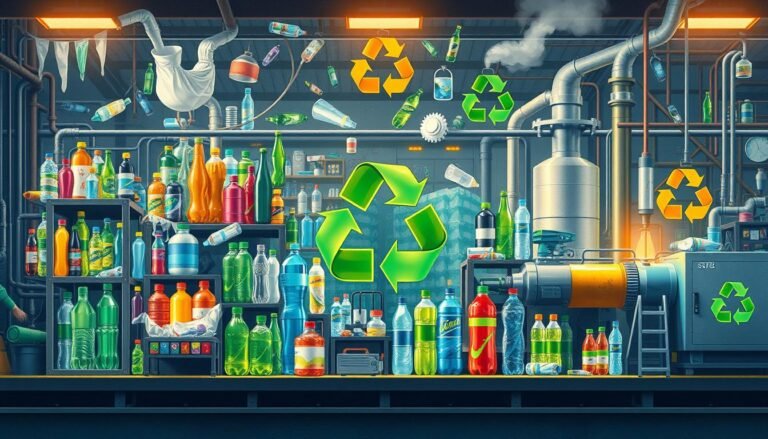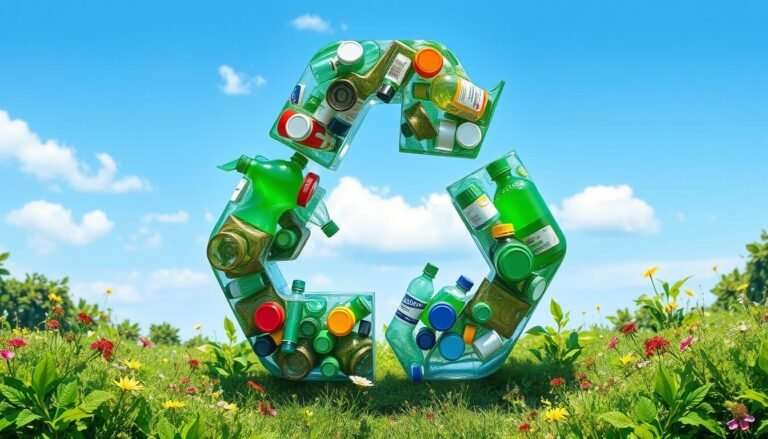Make some changes to the world environment
-
Building 3, Wanyang Innovation City, Langxia Street, Yuyao City, Zhejiang Province
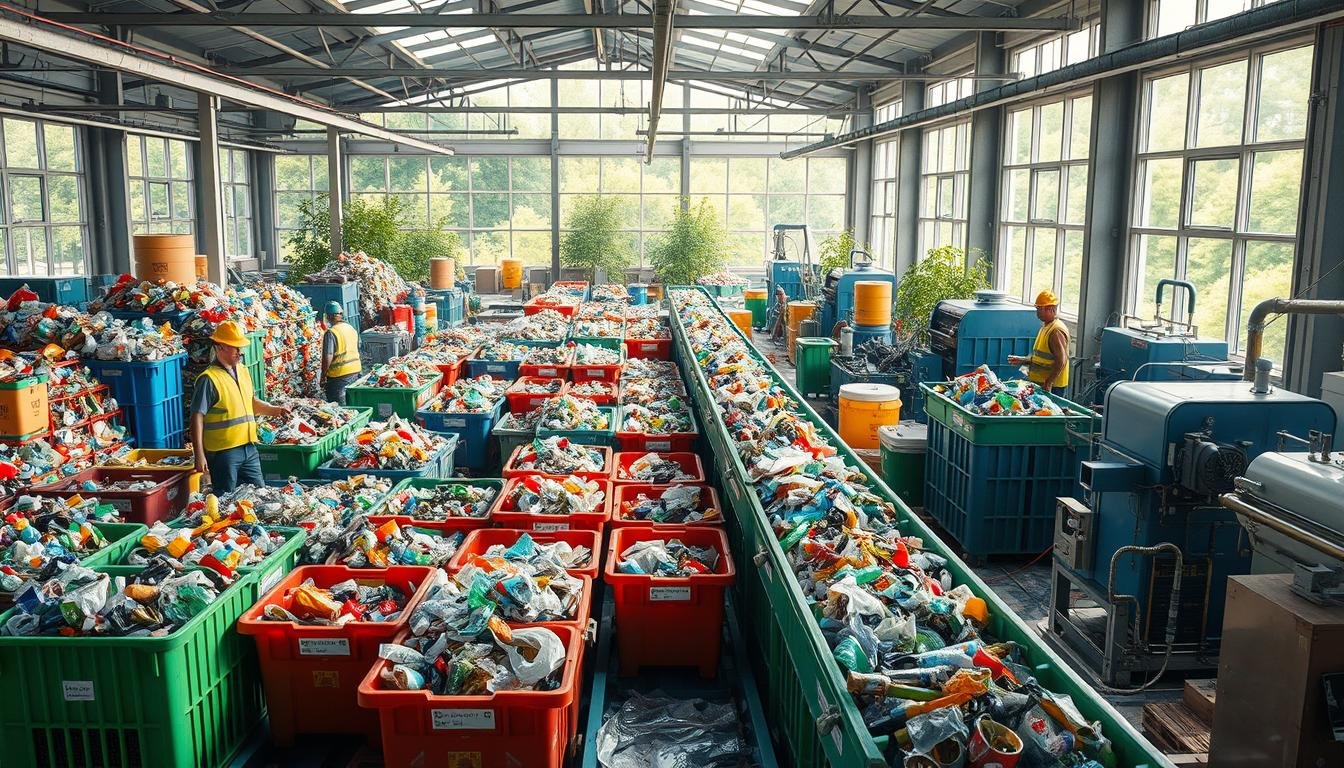
Understanding Plastic Recycling Rates
Have you ever thought about how much plastic we actually recycle? This question uncovers some startling truths. It shows us the big challenges we face in recycling plastic waste. Despite our best efforts to recycle, there’s a big gap in how effective global plastic recycling truly is.
An exploration into plastic recycling rates helps us see the real picture. It guides us towards making better, more sustainable choices for our future.
We’re diving into the complex world of plastic recycling to make the statistics and processes clearer. Knowing our global standings, the techniques used, and the main hurdles can help us find better recycling solutions. True change in recycling rates comes from being informed and taking strategic steps.
Out of the 430 million tons of plastic made every year, only 9% gets recycled. This leaves a huge amount of waste we need to deal with1. This fact alone shows the pressing need for effective plastic waste strategies. We aim to give you a clear path to boost global recycling rates by focusing on how much plastic is recycled, the types of plastics recycled, and the challenges we face.
Click here to learn more about PVC recycling and how it helps improve recycling rates.
Key Takeaways
- A shocking 9% of the 430 million tons of plastic produced every year is recycled. This leaves a lot of it as waste1.
- Most plastic waste, about 79%, ends up in landfills or littering our planet2.
- Some countries, like South Korea and China, recycle more than 30% of their plastic. This shows they have effective strategies3.
- Things like economic barriers, contamination, and lack of facilities limit recycling efforts3.
- Knowing how well different plastics like PET and HDPE are recycled is key to improving processes2.
Introduction to Plastic Recycling Rates
Understanding plastic recycling rates is key when talking about recycling. These rates show how much plastic waste gets turned into new items. It’s vital to know this to judge how good recycling efforts are everywhere. Right now, only 9% of plastic gets recycled worldwide. That means a lot goes to waste, with 57% ending up in landfills and another 29% burned4.
What are Plastic Recycling Rates?
Plastic recycling rates tell us how much plastic waste gets a new life as usable materials. For example, only 15.4% of PP plastic bottles were recycled in the US in 20204. Knowing these percentages helps us see if recycling plans work. Some places have boosted bottle recycling with special laws that give money back for returns5. This info helps set goals and check on our progress towards a greener planet.
Importance of Accurate Recycling Statistics
Good recycling data is super important. It shows us how recycling programs are doing and points out what needs to get better. For example, Europe recycles 38% in packaging but does worse with construction materials4. The US is only recycling about 5%, showing big weaknesses5. Having the right stats helps make smart decisions, use resources wisely, and see if laws are working. It also makes the recycling world more open and keeps everyone honest.
Current Global Plastic Recycling Rates
Today, recycling rates for plastic vary greatly across the world. This variation shows a big need to boost recycling methods. With more plastic being made and environmental challenges growing, it’s urgent to get better at recycling.
Worldwide Recycling Statistics
The global situation about plastic recycling is worrying. Around 85% of plastic packages end up in landfills, even with efforts to do better6. Just 9% of all plastic waste gets recycled, showing how current systems aren’t working well7. If we don’t upgrade how we manage waste, especially in poorer countries, plastic pollution will keep going up7.
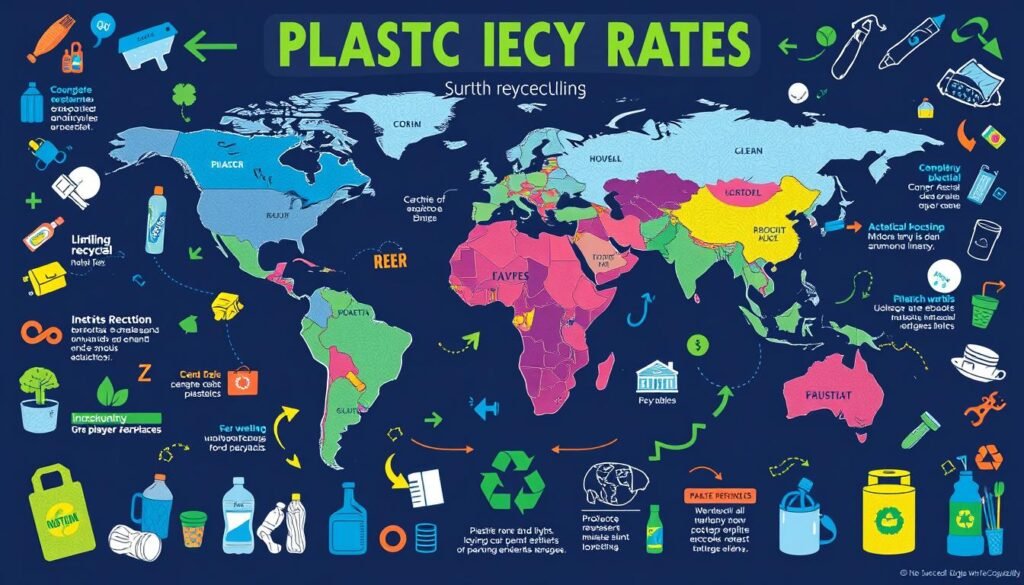
Country-Specific Recycling Rates
Recycling rates by country are very different. South Korea and Germany are ahead because of their effective recycling methods. But in the United States, only about 5% of plastic waste from households was recycled in 20216. We could really help the planet if we made recycling systems better and got more people involved.
Comparing Recycling Efficiency Across Nations
Looking at recycling efficiency around the world, it’s clear that places with better waste management do better. For example, the European Union’s ban on single-use plastics is a strong move to boost recycling6. On the other hand, countries with weak waste systems face more plastic ending up in the environment7. Pushing for global recycling goals is key to reducing differences and making recycling better everywhere.
How Much Plastic is Actually Recycled
In the U.S., we generate about 48 million tons of plastic waste every year. But only about 5% to 6% of this gets recycled89. This fact points out a big problem with how we recycle plastic, urging us to take action quickly.
Globally, more than 85% of plastic packaging ends up not being reused but thrown away6. This shows a huge problem between making plastic and recycling it properly. We need to check the situation honestly and make much stricter rules to fix these issues.
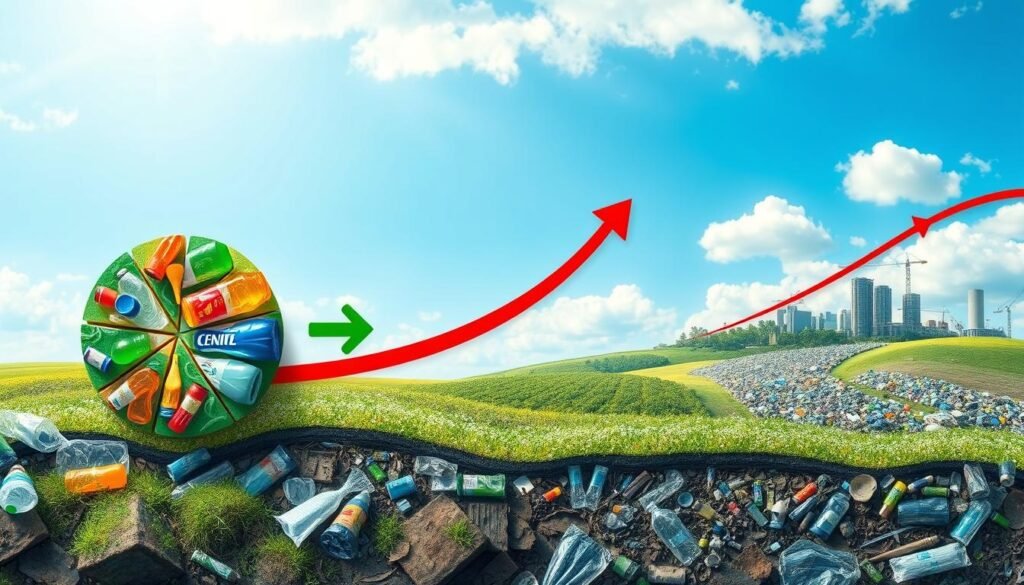
How well we can recycle plastic depends a lot on the type of plastic. PET and HDPE plastics, like those in water bottles and milk containers, are recycled the most6. Yet, plastics labeled 3 to 7 are hardly recycled because they’re not as valuable6.
Even though not much plastic is recycled, the industry keeps asking for more recycling. At the same time, they don’t want to stop making new plastics8. This ends up making the recycling efforts scattered and not really solving the big problem of too much plastic waste.
Experts think that by 2050, the amount of plastic we make will triple8. By 2060, it could increase even more worldwide6. The good news? Over 170 countries are coming together under a UN treaty to fight plastic pollution8. This could really help make recycling more effective all over the world.
Here’s a deeper look at some plastics we recycle often and how much of them actually get recycled:
| Plastic Type | Recycling Rates |
|---|---|
| PET | ~20% |
| HDPE | ~30% |
| PP | ~10% |
| More than 90% non-recyclable plastics | <1% |
Key Types of Recycled Plastics
In the world of recycling, knowing the different types of plastics is key. PET, HDPE, and PP are recycled at different levels of success. We’ll look at these types and how they’re recycled.
Polyethylene Terephthalate (PET)
PET is a plastic often used for drink bottles and food containers. In the US, about 31% of PET is recycled. Europe does better, recycling 52% of PET10. We need to get better at recycling PET, just like Europe, to save resources and reduce waste impact.
High-Density Polyethylene (HDPE)
HDPE is found in milk jugs and detergent bottles and is fully recyclable. It’s the second most recycled plastic, after PET10. With a $7.5 billion investment in recycling technology, HDPE recycling has improved a lot11. Better HDPE recycling means less waste and a cleaner planet.
Polypropylene (PP)
PP is used for things like yogurt tubs and bottle caps but it’s not recycled much10. This is a problem because PP is in high demand and very useful. We need to recycle PP better to keep it from adding to waste piles.
The table below shows how PET, HDPE, and PP compare in recycling:
| Plastic Type | Common Uses | Recycling Rate (US) | Recycling Rate (Europe) |
|---|---|---|---|
| PET | Beverage bottles, food containers | 31% | 52% |
| HDPE | Milk jugs, detergent bottles | Second highest after PET | Not specified |
| PP | Packaging, yogurt tubs | One of the least recycled | Not specified |
Better recycling of PET, HDPE, and PP is crucial for less waste and a circular economy. By focusing on these plastics, we can make big environmental improvements.
Challenges in Plastic Recycling
Plastic recycling has big problems that make it hard. One main problem is how dirty recycling gets. Non-recyclable stuff often gets mixed with stuff that can be recycled. This mix-up means many recyclables don’t get reused but are thrown away instead. In fact, only 9% of all the plastic waste gets recycled. About 50% ends up buried in landfills. Meanwhile, 22% is just dumped outside with no care12. Dirt and wrong materials greatly up the cost of sorting and processing. This makes recycling not worth the money for many.
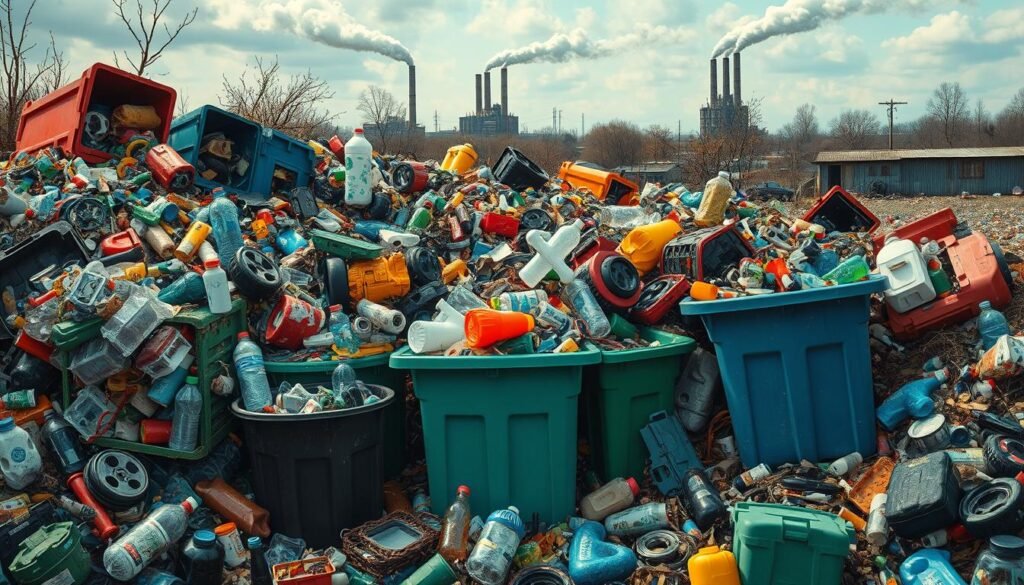
Contamination Issues
Things that shouldn’t be there, like leftover food, wrong plastics, and trash, mess up the recycling. Because of this, about 10% of stuff meant to be recycled gets thrown away instead13. Dirty recyclables cut down on the quality of recycled materials. They also make it cost more to run recycling operations.
Economic Barriers
Recycling plastic is often more expensive than just making new plastic. This is because the price of new plastic changes with oil prices. Also, there’s just too much new plastic being made – twice as much now than in 2000. We’re at 460 million tons now12. In the United States, 85% of plastic trash goes to landfills. Only 10% is burned, and just 5% is actually recycled as of 202112. Cheap, new plastic makes it tough for recycling to compete.
Lack of Infrastructure
The United States doesn’t have the right setup to recycle plastic well. There aren’t plans for new recycling centers anytime soon12. The problem is even worse in places with less money and technology. This makes worldwide recycling numbers very low. Unlike aluminum, which gets recycled a lot because it doesn’t lose quality, plastic struggles.
To fix these problems, everyone needs to work together. Governments, companies, and people can help by paying for better technology to sort recyclables. They can also help by teaching everyone why recycling is important. Building better places to recycle will help too. Finding new ways to recycle tough plastics is key. Such innovative ideas are talked about here12. With teamwork, we can create a system that manages plastic in a good way for the Earth.
Environmental Impact of Low Recycling Rates
Low recycling rates are a big problem for the environment. They cause pollution and harm animals. Plastics that aren’t recycled often end up in landfills or the ocean. This is bad for land and sea creatures. The amount of plastic waste in the U.S. grew from 7.4 million tons in 1980 to 35.7 million tons in 201814. Sadly, only 5 to 6 percent of the 40 million tons of plastic waste here was recycled last year. This leaves a lot of waste to harm natural places14.
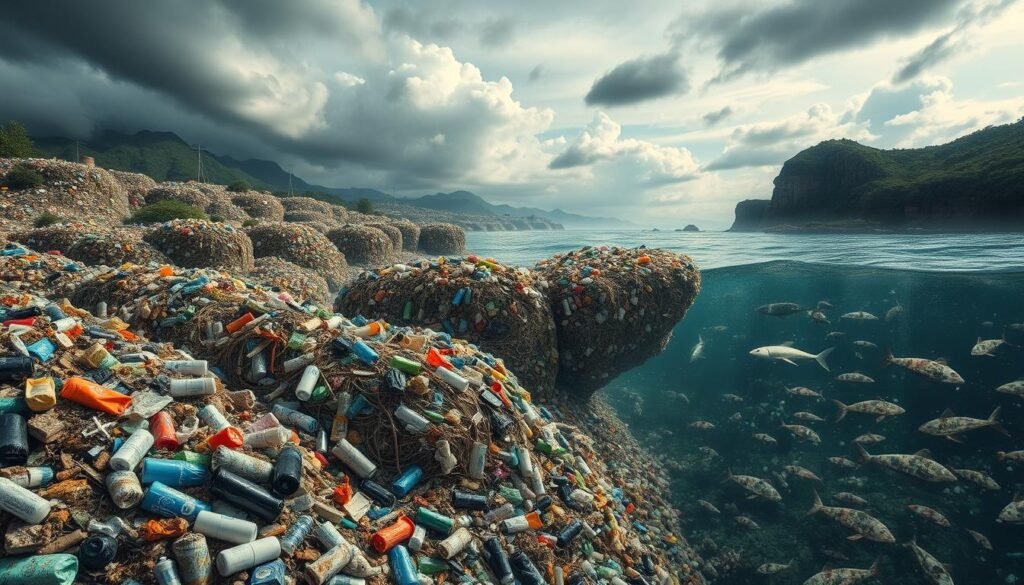
Pollution and Wildlife Harm
Not recycling enough leads to more waste in nature. For example, in 2021, U.S. homes made about 51 million tons of plastic trash. But only 2.4 million tons were recycled15. Most of this trash ends up in water, which can trap and poison sea animals. About 85 percent of plastic trash was thrown in landfills. This makes pollution worse and fills up landfills quickly14. Plastic in nature disrupts the homes of wild animals and is a big danger to them.
Contribution to Climate Change
Poor recycling also makes climate change worse. Almost all plastics come from fossil fuels, which add a lot to greenhouse gas emissions15. When we don’t recycle, we need to make more plastic. This increases the harmful gases from making plastics. Making and throwing away plastics sends a lot of carbon into the air. This makes global warming happen faster. Plus, the U.S. recycled even less plastic in 2021 than in 2018, going from 8.7 percent to just 5-6 percent14. We must tackle these problems to fight recycling issues and climate change. This will help us have a healthier planet in the future.
It’s very important to start better recycling programs now. To learn more about recycling, especially HDPE plastic, check out our guide here.
Working together, countries can face the big challenges of low recycling rates. This is key to protect our environment for everyone in the future.
Innovations in Plastic Recycling Technology
As we tackle plastic waste, groundbreaking recycling technologies are leading the way in solving global environmental issues. The use of advanced sorting methods has significantly uplifted the accuracy and speed of recycling plastics. For example, near-infrared (NIR) spectroscopy helps quickly sort different plastic types. This reduces mistakes and makes recycling flow better.
Moreover, we’re seeing breakthroughs in chemical recycling. This method breaks plastics back down into their basic building blocks. These can then be turned into high-quality plastic goods again. It’s very useful for types of plastics that are hard to recycle in the usual ways.
Another promising field is the development of biodegradable plastics. These are designed to break down naturally in certain conditions. This can lower the stress on recycling systems and cut down pollution. NatureWorks is leading in making bioplastics from things like corn starch.
But it’s crucial to apply these tech advancements effectively. In North America, the demand for recycled plastics is much higher than the supply, meeting only 6% of the need for most plastics16. Plus, plastic production is expected to jump by 40% by 2030. It might even double or triple by 205017. This shows how urgently we need recycling solutions that work well and can grow.
New recycling technologies are not just making recycling better. They’re also helping pave the way towards a greener future. It’s important for different industries to work together closely. This will help break through barriers and increase recycling worldwide.
Let’s look at the breakthroughs changing the plastic recycling sector:
| Innovation | Description | Impact |
|---|---|---|
| Advanced Sorting Technologies | Use of NIR spectroscopy for precise plastic identification and sorting | Reduces contamination, improves recycling efficiency |
| Chemical Recycling | Breaks down plastics into their monomers for high-quality reprocessing | Can handle complex polymers, enhances material quality |
| Biodegradable Plastics | Plastics designed to decompose under specific conditions | Reduces reliance on traditional recycling systems, minimizes pollution |
The Role of Consumer Behavior in Recycling Rates
Consumer behavior has a big impact on how much we recycle. When people know a lot about recycling and join in, we get more and better recyclables. Studies show that 78% of shoppers look for recycling info on labels to throw things away right18. And, 53% seek out this info when they’re not sure if something can be recycled. This shows how consumers can shape recycling habits.
Also, when consumers trust the recycling info on labels, improvements are seen. A whopping 82% believe this information is right, while 71% would feel let down if they couldn’t actually recycle items marked as recyclable18. Clear and honest labels are key to making sure people recycle correctly.
In spite of recycling challenges and plastic waste issues, consumer influence is crucial. In the UK, they produce nearly 4.9 million metric tonnes of plastic a year. Sadly, only 10% of this waste gets recycled19. If shoppers knew more about harmful plastic products and chose wisely, we could see better recycling numbers.
Teaching people and getting them to sort correctly can also boost recycling. With 63% of consumers confused by recycling symbols on labels18, it’s clear we need better education and clearer signs. This will help everyone recycle more effectively.
By using less plastic, reusing items, and pushing for new rules, people can really make a difference. Consumers dedicated to saving our planet can help make recycling work better. To learn more about how consumer actions can impact plastic use, visit consumer power in the age of18.
The Push Toward a Circular Economy
Moving towards a circular economy is crucial for better recycling methods. Right now, too much plastic packaging is used once and thrown away. This wastes resources and creates trash. A circular economy changes how we grow, focusing on benefits for everyone by recycling more and wasting less.
Studies show that 53% of plastic packages can be recycled or turned into compost. In fact, 72% could be recycled if we improve our methods20. To do this, we must design products that are easier to recycle. The Ellen MacArthur Foundation tells us that reusing and cutting down on plastic will help reduce waste20. Learn more about circular economy principles here.
From 1950 to 2015, less than 10% of all plastic waste was recycled21. This fact shows we need to act fast to manage our plastic trash better. Only about 9% was recycled, and 12% burned, which harms the environment21. Yet, reducing new plastic use by 18% since 2019 shows progress is possible with hard work.
In the EU, too much plastic packaging still ends up in places it shouldn’t. Even though recycling has improved, less than half of all plastic waste is recycled22. This means there’s a big chance to do better and recycle more for a circular economy.
The circular economy is good not just for the planet but also for businesses. An 86% majority of investors think that companies focused on the circular economy will make more money in the long run21. Interest in these kinds of investments has grown from 71% to 85% recently21.
We have big goals, like using more recycled plastic in packaging by 2025 and collecting more plastic than we sell20. Reducing plastic waste shipped to other countries is also crucial22. Meeting these goals will help us recycle better and support a healthier economy and planet.
To wrap things up, circular economy ideas can greatly reduce plastic waste. By making products last longer, improving how we recycle, and using items again, we can look forward to a cleaner, happier world. The benefits range from saving the environment to economic gains, showing how big of an impact these efforts can have.
Conclusion
Understanding how to better recycle plastic is key for keeping our planet healthy and our economies strong. This analysis looked closely at worldwide recycling, the challenges experienced with various plastics, and how new tech and consumer actions can help. We covered a lot.
Right now, a shocking 91% of plastic isn’t recycled, ending up in landfills or polluting nature. We need everyone – from companies to governments to individuals – to work together to make recycling better23. For example, the healthcare sector is ahead with a 45% plastic recycling rate, showing us it’s possible to do better24. The beverage industry is also doing well, recycling 50% of its plastics. These successes can inspire improvement across all sectors24.
Looking ahead, embracing new technology and encouraging people to recycle are crucial for a greener future. Working together to overcome economic and structural hurdles will boost recycling worldwide. This journey to improve plastic recycling shows we all must help tackle the growing issue of plastic waste. By committing to this challenge, we can help protect our environment for future generations.


